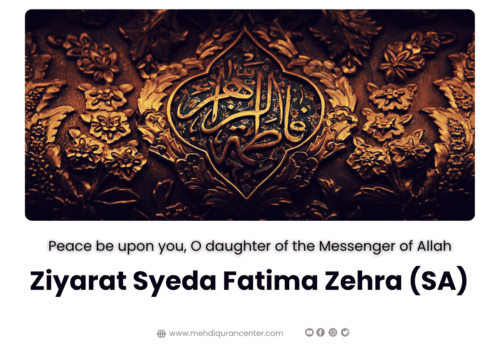The life and martyrdom of Hazrat Fatima Zahra (S.A), the beloved daughter of the Holy Prophet Muhammad (PBUH), hold a sacred place in the hearts of Muslims across the world. Revered as the Sayyidatun Nisa al-Alamin — the Leader of the Women of the Worlds — she is a beacon of purity, courage, and devotion whose example continues to guide believers more than fourteen centuries later.
In the Shia School of Thought, the days following the demise of the Holy Prophet (PBUH) are marked with deep sorrow, as they recount the trials and oppression faced by his noble daughter, Hazrat Fatima (S.A). Yet, her response to these hardships with steadfast patience and unwavering faith stands as a timeless lesson for humanity.
Who Was Hazrat Fatima Zahra (S.A)?
Hazrat Fatima Zahra (S.A) was born in Makkah around 605 CE, to the Prophet Muhammad (PBUH) and Lady Khadijah (S.A). Her birth was accompanied by divine blessings — as the Prophet (PBUH) himself said, “Fatima is part of me; whoever harms her harms me.”
Her personality reflected the noblest qualities: she was deeply spiritual, humble, and generous. The Prophet would often rise to his feet when she entered a room, calling her “the mother of her father” (Umm Abiha) — a reflection of her deep love and care for him.
Through her marriage to Imam Ali ibn Abi Talib (A.S), she became the mother of Imam Hasan (A.S), Imam Husain (A.S), Sayyida Zainab (S.A), and Sayyida Umm Kulthum (S.A) — the family known as Ahl al-Bayt (A.S), whose spiritual legacy defines the essence of Islam.
The Period of Sorrow After the Prophet (PBUH)
After the passing of the Prophet Muhammad (PBUH), Hazrat Fatima Zahra (S.A) endured immense grief. Her father had been not only her parent but her greatest support, her teacher, and her source of comfort.
In the months that followed, historical accounts — including Shia and some Sunni sources — mention the immense emotional and physical suffering she endured due to disputes surrounding the succession of leadership (Imamate) and the issue of Fadak, a piece of land gifted to her by the Prophet (PBUH).
The Sermon of Fadak, delivered in the mosque of Medina, remains one of the most profound speeches in Islamic history. In it, Hazrat Fatima (S.A) eloquently defended the Prophet’s message, spoke about justice, and reminded the community of their responsibilities towards the teachings of Islam.
Her words continue to echo through time, serving as a reminder of her unparalleled wisdom, courage, and eloquence.
The Painful Events Leading to Her Martyrdom
According to the Shia tradition, Hazrat Fatima Zahra (S.A) suffered grave injuries during the political turmoil following the Prophet’s demise. She was physically harmed during an incident at her home, leading to severe wounds that resulted in the miscarriage of her unborn son, Mohsin (A.S).
Despite her suffering, she never raised her voice in anger or revenge. Instead, she turned to prayer, patience, and supplication to Allah. Her endurance in the face of oppression became a reflection of the Qur’anic verse:
“Indeed, Allah is with those who are patient.” (Surah Al-Baqarah, 2:153)
Her martyrdom occurred just a few months after her father’s passing — at an age said to be between 18 and 23 years, depending on various narrations. The Shia world commemorates her martyrdom in the months of Jumada al-Awwal and Jumada al-Thani, in what are known as the “Ayam-e-Fatimiyyah”, days of mourning dedicated to the remembrance of her sacrifice.
Her Will and Secret Burial
Before her passing, Hazrat Fatima Zahra (S.A) made a poignant will to Imam Ali (A.S) — that she should be buried at night and that her grave should remain unmarked. This wish symbolised her silent protest against the injustices she faced.
Her burial took place quietly in Medina, attended only by a few loyal companions. To this day, the exact location of her grave remains unknown, adding to the sorrow that surrounds her memory and serving as a powerful symbol of her patience and modesty.
Legacy and Spiritual Significance
The legacy of Hazrat Fatima Zahra (S.A) is not one of mere grief, but of profound spiritual enlightenment. She is revered as the perfect role model for Muslim women and men alike — a symbol of faith, knowledge, humility, and devotion.
Her teachings on prayer, charity, and justice remain timeless. The Tasbeeh of Fatima Zahra (S.A) — reciting SubhanAllah (33 times), Alhamdulillah (33 times), and Allahu Akbar (34 times) — is among the most recommended daily acts of remembrance (Dhikr) in Islam.
Imam Ja’far al-Sadiq (A.S) said:
“We teach our children the Tasbeeh of Fatima Zahra (S.A) as we teach them how to pray.”
Her light continues to guide those who seek truth, especially within the Shia tradition, where her life is commemorated with utmost reverence through Majalis, Ziyarat, and acts of charity in her name.
A Symbol of Unity and Faith
While Shia Muslims commemorate her martyrdom with deep mourning and reflection, it is essential to note that Hazrat Fatima Zahra (S.A) holds a sacred place in the hearts of all Muslims — Shia and Sunni alike.
She was the beloved daughter of the Prophet Muhammad (PBUH), and her virtues are universally acknowledged in both schools of thought. Her life reminds us of the importance of justice, modesty, and the defence of truth — values that transcend sectarian lines.
Commemorating her Shahadat is not an act of division, but of remembrance — of standing for righteousness, compassion, and devotion to Allah.
Lessons from the Shahadat of Hazrat Fatima Zahra (S.A)
- Patience in adversity: She endured unimaginable trials without complaint, embodying the essence of sabr (patience).
- Courage for truth: Even in isolation, she spoke out against injustice, setting an eternal example of moral strength.
- Love for the Prophet (PBUH): Her life was an extension of his teachings — mercy, kindness, and steadfast faith.
- Defender of faith: Through her words and actions, she preserved the message of Islam in its purest form.
- Symbol of purity: Her name, Al-Zahra, means The Radiant One, a reflection of her spiritual brilliance and connection to divine light.
Commemorating Ayam-e-Fatimiyyah
During Ayam-e-Fatimiyyah, believers gather to remember her sacrifice through Majalis, recitation of Ziyarat-e-Fatima Zahra (S.A), and reflections on her life. Many perform acts of charity in her honour — feeding the poor, helping the needy, and spreading her message of compassion.
At Al Mehdi Online Quran Center, we dedicate these days to teaching her virtues, organising online Majalis, and helping students learn about the Ahl al-Bayt (A.S) with love and respect.
Conclusion
The Shahadat of Hazrat Fatima Zahra (S.A) is not merely a historical event — it is a call to the conscience of every believer. Her story reminds us that truth, patience, and faith must prevail even in times of darkness.
As we mourn her loss, we also celebrate her eternal light — a light that continues to illuminate the path of Islam and guide hearts towards Allah.
May our remembrance of Sayyida Fatima Zahra (S.A) bring us closer to her father, Prophet Muhammad (PBUH), and strengthen our connection to the divine message of peace, justice, and love.
🕊️ “Peace be upon you, O daughter of the Messenger of Allah. Peace be upon you, O leader of the women of the worlds.”








